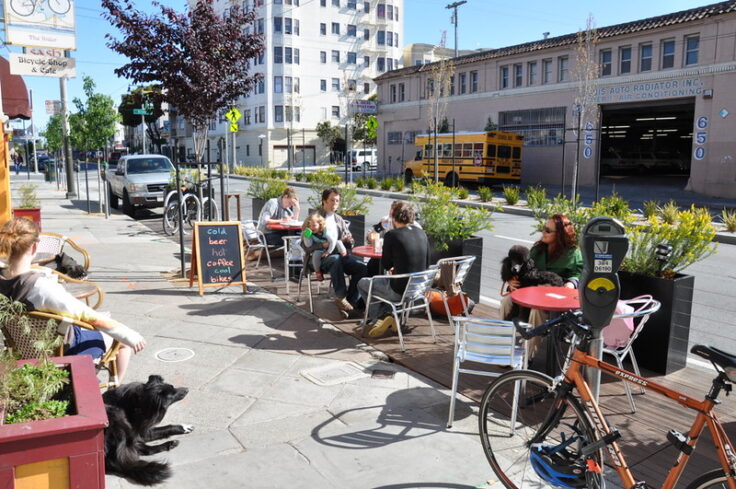February 01, 2024
In These US Cities, Parking Reform is Gaining Momentum
Parking reform, an often overlooked component of the sustainable transport movement, has taken to the national spotlight in the US as it gains momentum in both policy and practice.
Read more about how off-street parking reform can benefit the climate and improve quality of life.
Cities and states across the country are realizing that rethinking parking frameworks can be a crucial lever in reaching broader transport, housing, and sustainability goals. Major urban areas like Austin, Texas have garnered attention recently as the largest city to do away with their parking requirements, while the entire state of California has eliminated parking minimums on developments within a half mile of major transit stops.
In the country’s largest city of New York, with over eight million inhabitants, proposals to remove off-street parking requirements aim to combat rising costs for construction and housing development. While it may be a trending story in the past year or so stateside, such efforts to reclaim public space through parking reform are certainly not new. Most notably, major cities like London, England eliminated parking minimums in the early 2000s and Mexico City, Mexico has been leading a similar charge over the past ten years with support from ITDP.

Off-street parking reforms – which include the elimination of parking minimums, the introduction of parking maximums, and other changes that disincentivize car use – is becoming an increasingly salient public issue, presenting an opportunity for many levels of government to make meaningful changes to the way that limited city space is utilized. ITDP’s 2023 Breaking the Code: Off-Street Parking Reform report highlights various strategies and lessons that can be gained from several model cities and countries that are leading the way on these types of reforms.
Among the case studies highlighted in the report, US cities like Minneapolis and Atlanta have demonstrate that their exist opportunities and to reshape outdated approaches around parking, land use, and mobility. While not without its challenges, this growing movement to transform off-street parking strategies can significantly improve how people live, work, and experience their urban environments. Ultimately, when excessive amounts of public space is allocated to cars, there is less space for jobs, services, housing, and sustainable transport options. This both constricts the amount of space in cities for essential services and destinations while also raising the costs of urban living.
Notable examples of US cities that are taking action to develop and institutionalize new approaches to parking and land use development include San Francisco, Minneapolis, and Atlanta.
San Francisco, California
In 2019, San Francisco did away with parking minimums. This was the result of a unanimous recommendation from the City Planning Commission, which called for the removal of all minimums without exception or caveat. Additionally, many land uses have implemented parking maximums. Paired with robust on-street parking reform, including a demand responsive parking pricing model that has been in place since 2011, San Francisco has long been a model city for successful parking reform. With only 3% of space in the central city dedicated to parking, it is one of the least parking centric cities in the United States. This has also allowed San Francisco to be among the highest ranks of walkable, bikable, and transit-friendly places in the US, painting a picture of a future in which policies center people over cars.

Minneapolis, Minnesota
The city of Minneapolis took an incremental approach to parking reform, as highlighted in Breaking the Code. The city’s first parking reform package, introduced in 2009, reduced parking requirements overall and eliminated them completely in downtown districts. Citing data collected after the first package of reforms allowed for even more progressive reform in 2015, which again reduced or eliminated minimums for residential buildings depending on their proximity to transit and number of units. The success of these two parking packages created enough momentum that by 2021, the City Council was able to eliminate parking minimums citywide while simultaneously decreasing maximums.
The city was able to make these reforms by pointing to two major influencing factors: the success of previous case studies (such as San Francisco), and the importance of lowering car dependency for the sake of slowing climate change. Minneapolis’ incremental and data-driven approach allowed them to lead the way for meaningful parking reform that has produced real results, including decreased residential parking construction over time.

Atlanta, Georgia
A city known for its expansive highway network and car dependency, Atlanta may not be an immediate thought of cities that are making meaningful change towards parking reform. But in 2015, the city commissioned consultants to conduct a review of existing zoning policy and make recommendations for possible improvements. The resulting diagnostic made a sweeping range of recommendations for the city’s updated zoning ordinance, principal among them being the replacement of parking minimums with parking maximums. While a proposal to implement this was introduced in 2021, it was tabled due to public feedback that the change was coming in too fast. This gives credence to the benefits of a more incremental approach, like the one utilized by Minneapolis. The city hopes to introduce a more comprehensive zoning update by 2025, which may allow more time for a groundswell of support surrounding parking reform.

Ultimately, parking reform is about a lot more than just where we put our cars. Allowing parking supply to be responsive to actual demand – rather than arbitrary parking minimums – is an issue that concerns the economy, the environment, accessibility, affordability, and many other issues that are central to the future of our cities. There are many important land uses that cities must juggle, from hospitals and affordable housing to recreation and retail. Alleviating the burden of required amounts of parking that exceed market demand allows cities to spend more resources on these important functions rather than financing the storage of idle vehicles.
While parking reform can be a lengthy process, rising public knowledge of the issue provides a perfect opportunity for advocates to make real and lasting changes on a faster timeline than may have previously been possible. Many cities may benefit from starting at smaller scales – first eliminating minimums in downtown districts, or implementing maximums before removing minimums – and spending more time making sure that public support is behind the changes.
An incremental approach is often critical to the success of long term parking management, but this should not come at the expense of slowing down progress. Cities and higher levels of government need to make it clear that removing parking minimums does not remove the ability to maintain or even build new parking spaces. Instead, removing minimums gives developers more options to provide usable housing, retail, or commercial space or to provide parking. Simultaneously making changes while providing consistent and publicly available data about the positive changes cities see as they introduce these changes may also help the broader public to understand the benefits of reforms.
As parking reform advocate Donald Shoup suggests: “Cities will look and work much better when prices, not planners and politicians, govern decisions about the number of parking spaces. Like the automobile itself, parking is a good servant but a bad master.”
